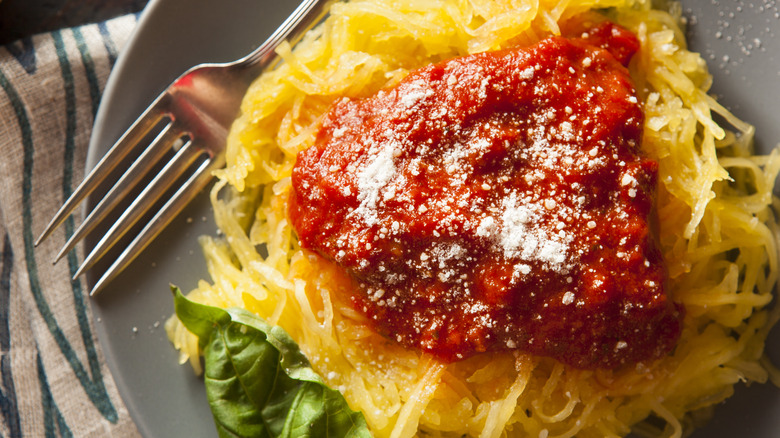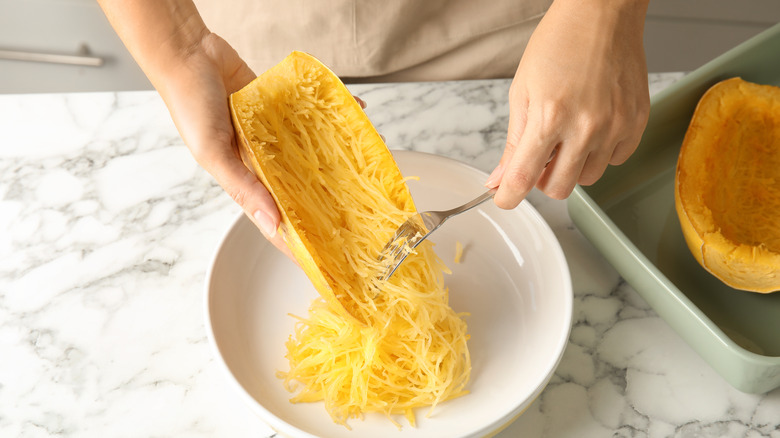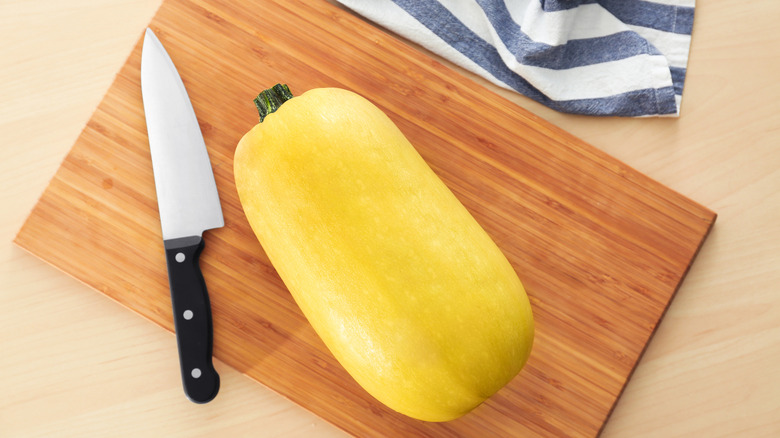The 2 Best Methods For Cutting Spaghetti Squash, Explained
Many of the best low-carb alternatives to pasta involve spiralizing, whether with a fancy machine or a veggie peeler. While our best tips for working with noodles include a recommendation that you spiralize your own zucchini and butternut squash for a great pasta alternative, there is a caveat. For your first time working with vegetable pasta, spaghetti squash may be a better option for the simple reason that the prep is so much easier.
Luckily, turning a big yellow spaghetti squash into a steaming hot plate of pasta, won't involve doing any peeling. Although you will have to scoop out the seeds, according to Epicurious, you'll likely find it a lot more straightforward than scraping the seeds out of a zucchini or cucumber. But the scooping only happens after the cutting. As for the cutting, there are two best methods of going about it. Both are simple, and one is even simpler.
Before we can get to that, however, we're going to share a little secret for making the easy slicing of spaghetti squash even easier. Use a paring knife to puncture the skin and flesh in about 10 places. Then simply set it in the microwave for five minutes and use potholders to transfer the squash to a cutting board. Now we can move on to the two best methods for cutting spaghetti squash.
How to cut your spaghetti squash lengthwise
The easiest and least work-intensive way to cut a spaghetti squash is lengthwise — like you're slicing potatoes into halves for our loaded potato skins recipe. In fact, the process involved in cutting a spaghetti squash lengthwise is quite a lot like prepping potatoes for loaded potato skins. Stand the squash lengthwise, and slice down at the center to make two boat-like halves (per Jessica Gavin). Then scoop out the seeds and pulp using a big, sturdy spoon. It's even easier than scooping out potato flesh because the seeds and pulp give you a template; once they're gone, your spaghetti squash is ready for the oven.
For our spaghetti squash lasagna boats recipe, recipe developer Hayley MacLean recommends preheating your oven to 425°F, rubbing one tablespoon of olive oil onto the cut halves, sprinkling with salt and pepper, and cooking cut-side down, either on parchment paper or directly on a baking sheet smeared with a little oil. When your oven has come to temperature, pop your baking sheet in and allow it to cook for 15 to 20 minutes. Then flip your squash to cut side up and cook for another 15 to 20. The flesh should be soft enough at this point to scoop with a fork. It will separate into spaghetti-like strands. Then top your veggie spaghetti with the sauce of your choice, marvel at your handiwork, and, of course, enjoy your low-carb pasta.
How to cut your spaghetti squash into rings
There's another method for slicing spaghetti squash before you cook it, and we like to think of it as the "gourd of the rings." It's a little more complicated, but some swear by it, although not The New York Times, which offers only the lengthwise method, nor Epicurious, whose food editor, Anna Stockwell noted that she finds it "too fussy," whereas she didn't "notice much difference" in the finished product compared with the lengthwise-cutting method. That being said, our patron saint of domesticity and friend of Snoop, Martha Stewart, seems to be a fan of turning spaghetti squash into the gourd of the rings. So, of course, we shall take that under advisement.
In her roasted spaghetti squash recipe, Martha Stewart recommends laying the squash horizontally on the cutting board, the flattest side down, then slicing it at one-inch-wide intervals. Scoop the seeds out of rings with a spoon. Season with oil, salt, and pepper, and then Stewart recommends 20 minutes of rest time (presumably so the salt can work its osmotic magic) before cooking for 40 minutes at 400°F.
Stewart says that when your rings are ready, they should be caramelized and tender. You'll want to peel off the skin and fluff the flesh with a fork to make those long, spaghetti-like strands. Store in an airtight container, which will be good for up to two days.


